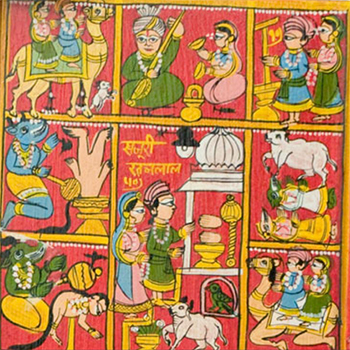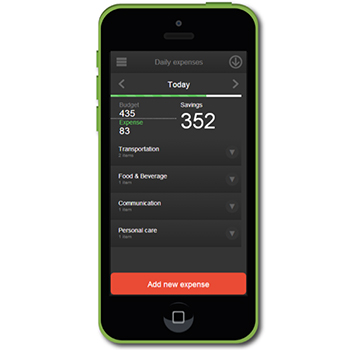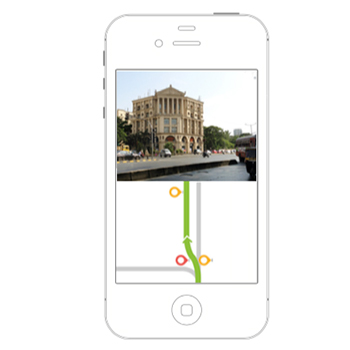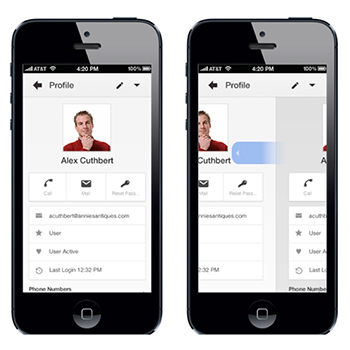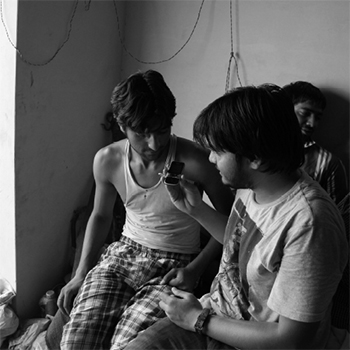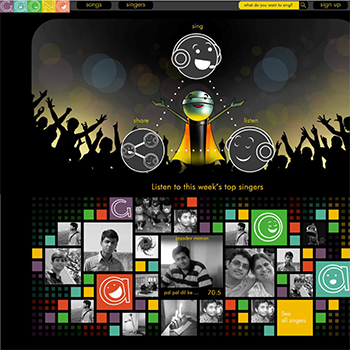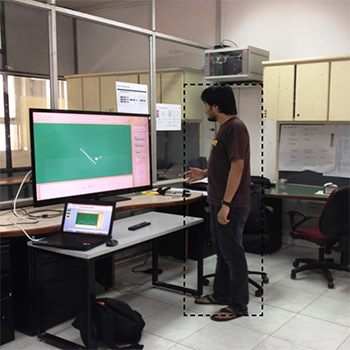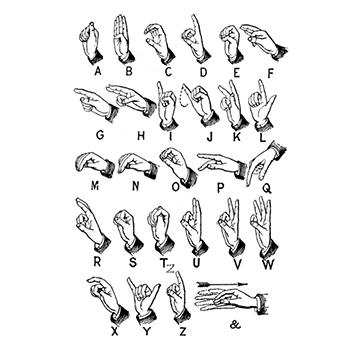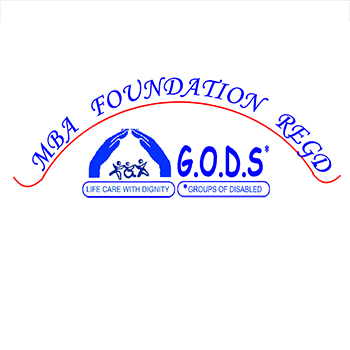Interaction Design
Batch 2012-2014
(25 items)
Interaction DesignBatch 2012-2014
(25 items)
(25 items)
Internship at Generator
by Astha Kabra
by Astha Kabra
They are digital natives who pioneer a brand into an already existing digital culture. Generator’s purpose is to recognize a brand’s energy and activate it, thereby connecting with an audience to aide the process of growing business. DYNAMIC It’s a fully loaded arsenal of turnkey multimedia capabilities that produces a unique project for each need. At Generator, they vivify dynamic messages to capture attention in a fast paced world inundated with information. ENGAGING The lifeline of a brand is engagement. Revenue conversion happens when they drive people to the brand with interactive content and leverage social media platforms effectively. USER CENTRIC Mobile, tablet and cloud capabilities are being unleashed everyday. A brand’s existence depends on being present at the intersections where users are communicating and exchanging information. Generator work alongside creative and business stakeholders to build intuitive and world class applications that people want to return to. MEASURABLE The gritty science behind the dazzling surface of digital media is the ruthless monitoring, analysis, assessment of results.
Details >>Food Home Delivery System
by Astha Kabra
by Astha Kabra
According to recent study, the frequency of eating out and ordering in has more than doubled and increased the demand in all for food services in Metro cities. As a result, it has become important to understand this fast-paced user dynamics in terms of demographics and behavioural differences of user while ordering food. It has been observed that the interaction of human beings with technology increases as the problem they are solving is frequent. Communication is fundamental in the new age, so is Food. We have internal notification for hunger from our body, but don’t have a seamless, time saving & beautiful platform to fulfill that demand. Across the country and majorly in the metros such as Mumbai, customers now demand for good food at the door step, whether at home or in office. ‘ Zayke ‘ (mobile app) provides solution which fills in the gap between the user’s and multiplicity of restaurants. The solution’s novelty lies in resolving the major issue of ordering in a group and from multiple places in one transaction. The users no longer need to store paper menus and offer coupons with limited validity. They can also explore the trending dishes, popular dishes, there eating patterns, flavour trails and calorie consumption. Moreover, the users have a platform to put their opinions, suggestions, reviews and recommendations directly.
Details >>Introducing Culture to Children through Storytelling
by Astha Kabra
by Astha Kabra
The project aims at introducing culture to children from 4 -7 years who are not in touch with their native culture or who have migrated from their hometown. The idea is it promote, foster and propagate Rajasthani culture through storytelling as it helps in enhancing active imagination and bringing in curiosity about their own roots. Giving them a tacit experience about Rajasthan by imitating certain cultural activities and taking them to a journey of fun, play and learn. This project is an attempt for designing a platform, which bridges the gap between children and there native culture. The challenge involved designing an interactive public space. This project involved study of space, interactions, sound, children behavior, architecture, history, stories, culture etc . Inspired from Kaavad, a traditional storytelling tool from Rajasthan, the installation is designed to transmit the culture hymn to young children. The project allows user you to experience different aspects of the tangible and the intangible culture of Rajasthan. Non - sequential stories, artifacts and activities makes the installation participative, playful and interesting.
Details >>Performance Animation
by Jaison Jacob
by Jaison Jacob
Affordance and low tech savvyness are the rea - sons why small budget films and independent film makers are not able to access the available high quality motion capture technologies. This project deals with the study of how to make an affordable technology for capturing facial expressions. It started with the study of the different kinds of motion capture, followed by their usage in films and the reasons why they are not affordable. Different techniques were evaluated based on their ease of use, learnability, affordance, and quality of the captured data. Based on the study, a low-cost technique was tested, and the process was documented as a quick learning tutorial for shortening the learning curve of a user.
Details >>Summer Internship Project
by Jaison Jacob
by Jaison Jacob
The team from Industrial Design Centre, IIT Bombay comprising of Edu Mohan, Jaison Jacob, Naveed Ahmed and Sourabh Pateriya visited Institute of Ergonomics (IAD), Technical University of Darmstadt, Germany, on a Student Exchange Program during May-June 2013. IAD specializes and carries out continuous research in the field of ergonomics with focus on vehicle ergonomics, work organization and production ergonomics. During the 6-week exchange programme, the team worked on a project and various workshops. While the project was three weeks long, the workshops usually were as short as two or three days. The workshops were randomly distributed over the 6-week period. Students from Interaction Design – Jaison, Naveed & Sourabh – worked on the project, the details of which are mentioned below. The project, Creating flexible workspaces in the IAD context, was completed by the team from Interaction Design over a period of three weeks. The workshops included learning new methods of decision making, design explorations, designing games, attending talks and providing design recommendations to a variety of project modules. The content in this report has been structured and divided based on the projects and workshops done. They have been ordered according to the duration and amount of work done during each assignment.
Details >>Touchscreen Malayalam Text Input for the Blind
by Jaison Jacob
by Jaison Jacob
This project involves the study of the structure of the Malayalam language, alphabets and the effective ways to represent them on a keyboard layout for making the text input process easier for the blind. Absence of a proper input and feedback mechanisms are the reasons why blind people are not able to use the touchscreen mobile devices for inputting text in Indian languages. This project aims to develop an effective Mobile touchscreen keyboard for the blind users to type in Malayalam. I studied different keyboards on Indian languages, learned how the blind users use the existing keyboards and designed keyboard layouts based on the insights derived from the study. Here vision is substituted with haptic and voice for the better Interaction between the blind user and the touchscreen, letting the user know where he is, giving two types of feedback to the user: What am I typing, what have I typed. I tried alternatives that are static, dynamic, circular as well as rectangular and these layouts were theoretically tested by comparing with each other and also with the existing Inscript keyboards that some blind users are experts with. The input is recorded from a touchscreen keyboard, stored as a Unicode and the output will be a display, haptic or a voice feed. After performing a theoretical testing on the alternative keyboards (static, dynamic; circular and rectangular), the dynamic circular keyboard is found more effective towards the parameters defined on the design brief (Chapter 7, section 1-3). This keyboard is subjected to further iterations and is prototyped as the final design. A usability evaluation is performed on the final design for measuring the attributes like: Overall effort, learnability, accuracy and speed. The final design achieved a speed of 1.05 words per minute (speed after the user underwent training for 3 hours with 100 complex Malayalam
words) and 0.41 words per minute (mean speed after the users underwent training for 30 minutes with 10 words each).
Details >>Personalized data Visualization for Enhancing Shopping Experience
by Jaison Jacob
by Jaison Jacob
The high effort/low reward mechanism to input expenses and lack of responsive money management (react positively, appropriately and quickly to user’s dynamic spending habits) are the reasons why people are not using the available mobile based personal finance applications to record their day to day expenditure.
This project aims at helping user to spend his money based on his needs and follows a logic based budget (a reasonable way of thinking about managing user’s money for his day to day activities) rather than following up a budget made over fixed and non-responsive assumptions like how much money left - how many days to survive.
Here I am using visualization as a tool for the user to generate insights about his expenditure and help him accomplish his meaningful goals. I am also using prediction of user’s daily budget and expenses to support user (remind user about expenses that he possibly may/may not have) and minimize the input effort.
This project led to the development of a mobile phone based finance application that involved the study of existing mobile personal finance applications, online shopping websites, identifying the existing problems and trying to solve each of them by different approaches.
I explored different ways to input expenses, create a responsive budget and finally designed a prototype and tested it over a period of 30 days for accuracy of the prediction and usability of input mechanism.
Details >>Jaipur Foot Innovation Par Excellence
by Naveed Ahmed
by Naveed Ahmed
Jaipur Foot Innovation Par Excellence highlights the groundbreaking design and development of the Jaipur Foot, a low-cost yet highly functional prosthetic that has transformed the lives of thousands of amputees in India and across the world. The video presents how this innovation stands out for its affordability, durability, and adaptability to varied lifestyles, particularly for users in rural and economically challenged settings. By combining human-centered design with practical engineering, the Jaipur Foot not only restores mobility but also dignity and independence, making it a globally recognized example of inclusive and socially impactful design.
Details >>Creating Flexible Workspaces
by Naveed Ahmed
by Naveed Ahmed
The team from Industrial Design Centre, IIT Bombay comprising of Edu Mohan, Jaison Jacob, Naveed Ahmed and Sourabh Pateriya visited Institute of Ergonomics (IAD), Technical University of Darmstadt, Germany, on a Student Exchange Program during May-June 2013. IAD specializes and carries out continuous research in the field of ergonomics with focus on vehicle ergonomics, work organization and production ergonomics. During the 6-week exchange programme, the team worked on a project and various workshops. While the project was three weeks long, the workshops usually were as short as two or three days. The workshops were randomly distributed over the 6-week period. Students from Interaction Design – Jaison, Naveed & Sourabh – worked on the project, the details of which are mentioned below. The project, Creating flexible workspaces in the IAD context, was completed by the team from Interaction Design over a period of three weeks. The workshops included learning new methods of decision making, design explorations, designing games, attending talks and providing design recommendations to a variety of project modules. The content in this report has been structured and divided based on the projects and workshops done. They have been ordered according to the duration and amount of work done during each assignment
Details >>Healthcare Screening Systems for Cardiovascular Diseases
by Naveed Ahmed
by Naveed Ahmed
Over the past two decades, sedentary lifestyles and unhealthy diet and occupational stress have led to a sharp rise in cases of cardio-vascular diseases (CVDs). Early subtle signs in these cases unusually go unnoticed and the disease gets identified when irreversible negative consequences become apparent.Through user studies, it was found that people neglect their health and get checkedup only when someone close to them falls sick; and sometimes only to realize that it is too late. These diseases could be avoided if diagnosed early through regular checkups and with enough awareness amongst susceptible groups. In the long run, this can prevent chronic illnesses. The project hence aims to create solutions for easy screening that would facilitate quick and hassle-free health check-ups.The project had three outcomes—trigger events that help engage new users into the health system, a healthcare kiosk where a user can get himself checked-up and an online interface to manage health data. All these are interconnected as a larger system.The social network of a patient who recently underwent a CVD is used to trigger and encourage preventive health behaviour among susceptible connections. This is done via direct intervention of the affected persons and online social networks. The social network includes the relationship of the user with members of the family and society.
The healthcare kiosk is an independent self-service setup where people can go and get themselves checked-up for signs that cause lifestyle diseases. The kiosk has
devices that measure body parameters and collect minimum information required for initial analysis. Suggestions and recommendations on further detailed check-ups, doctors’ information and future check-up schedules are then provided to the user based on the analysis The setup integrates with an online interface that takes health and family medical history of the user and assesses the risk to a particular disease over time. To predict risk, factors like hereditariness of a disease in the family and current medical data are used. The solution also encourages users to develop health behaviours that may help transform the current curative healthcare system to a more ‘collaborative’ one. As devices used were mainly self-help, the user evaluation concentrated on how (and if) the users understood the instructions provided to use these devices and their ability to finish the tests successfully.The devices were tested with the target user group and also those who have used personal medical devices earlier. Most of them could follow the video instructions and perform the tests themselves easily without much intervention. Part of the evaluation also consisted to social prototyping and finding the effect of
how the message spreads across one’s contacts. For this, the growth of an online questionnaire over time were analysed along with interviews. The online questionnaire
showed impressive results with most of the users referring family members than social contacts.
As part of the future work, there is a need to improve the motivation factor in the social network. The apparent and perceived hygiene of the kiosk is of prime importance that would drive people to actually use the system.
Details >>Navigation and Wayfinding - Using Schematic Maps and Landmark Data for Less-Educated Users
by Naveed Ahmed
by Naveed Ahmed
In India, where usage of printed maps is less and the reliance on asking around is higher, adaptation to existing online solutions is low. Asking around is influenced by several socio-cultural factors and in turn affects how wayfinding systems are designed. These include micro factors like the time of the day to macro factors like gender and personal biases. Using the hypothesis that a combination of schematic maps and landmark information will be an effective way of navigation, a prototype that uses these concepts was created. A combination of schematic maps that are widely used in transit networks and photographs of landmarks on the route can result in a new wayfinding system. Schematic maps are created using generalization techniques to make a map more usable and closer to users’ mental models. With the map showing the direction of travel, landmarks along the route can be used to move further and reach the intended destination. Here, landmarks along the route are used as checkpoints and nodal points. Checkpoints are intermediate milestones which the user has to achieve and nodal points are locations on the route where the user takes a turn from his current direction of travel. These are shown as points on the map and each of these have corresponding landmark
photographs associated with them. Hence, the
route is divided into segments that are completed
in a sequential manner. Nodal points with several
intersecting roads are provided with details of other
routes to guide the users accordingly.
The prototype created using the above concepts
was tested in comparison with an existing solution
(Google Maps) with users with less education. Some
of these users were first-time map users.
Two randomized sets of users—one using an existing
solution and one using the current concept—were
asked to reach a destination using the prototypes.
A/B Testing was also conducted to avoid bias.
During evaluation, users could use the application
successfully with most of them being able to identify
landmarks and reach the final destination without
much hassle. Comparative studies showed that
landmark-based navigation definitely has an edge
over other systems, especially when it comes to
taking the correct turn. Future work lies in creating a scalable model for generating data that will be required to make the
application usable and keep it up-to-date with the
changing environment.
Details >>Effect of Scale, Symbols and Number of Elements in Data Visualization
by Pebam Pritam
by Pebam Pritam
In order to identify the optimal visual representation for an specific kind of data and purpose, we need to measure the effectiveness of data visualizations. Several studies have been conducted to understand fundamental questions in this field — How do we define the effectiveness of a data visualization and how to quantitatively measure the effectiveness of data visualizations. McGill (1984) identified the ordering of the visual tasks on the basis of accuracy in terms of elementary perceptual tasks; his paper validates essential criteria over which certain visualization are more efficient than others. Zhu (2007) defines what is an effective data visualization and how to analyse quantitative data to provide a precise measure of effectiveness based on the accuracy, utility or efficiency. However, in all these existing studies, we did not find the effect of a base-scale, symbols or optimal number of elements in a specific data visualisation. In order to fill in this gap, we performed a preliminary experiment to measure the effect of these entities on data visualizations n this paper, we present the results of an experiment where we
studied i) the effect of having a base measure (scale) in datavisualizations; ii) the effect of using symbols in datavisualizations; iii) the optimal number of elements a
visualization should carry. Twenty five participants of both
genders between the age range of 20 to 30 were subjected to
a total of ten stimuli (2 to study the effect of base-scale, 2 to
study the effect of symbols and 6 to find the optimal number of
elements to be used in an data visualization). These stimuli
were presented in a random order and participants were asked
to answer questions based on the visualization, while at the
same time, the time taken for each answer was electronically
recorded through the system. Participants were asked to
answer the questions as fast as they could.
The collected data was analyzed using a method similar to the one suggested by Zhu. On the whole a students T-test was
used to measure significant differences between speed and
accuracy (error rate) of answers for each of the data
visualizations. Our results show that adding a scale has a
significant impact on the effectiveness of the visualization. A
visualization with a scale performed significantly better (p<0.1) than one without a scale in terms of its speed (12.67% faster), the error rate was also found to be lower (p<0.5) (33.56% less errors). We also found that the usage of symbols also makes an improvement in understanding the visualization and hence making it more effective, the time taken is again less (p<0.1) i.e (8.9% faster) and less errors (19.72% less errors) were recorded (p<0.5) when compared to a visualization without the use of symbols. However, our results to identify the optimal number of elements in a visualization did not yield any significant results. We hope that the findings of this study would help designers create more effective data visualizations.
Details >>Google Mobile Cpanel Admin App
by Pebam Pritam
by Pebam Pritam
Google Mobile Cpanel app is the admin console for Enterprise Google Apps for mobile devices. Google Apps is a cloud-based productivity suite which comprises of several
Google services/products including Gmail, Google docs, Google drive, Google Calendar etc for enterprises, SMBs or teams. Through Google Apps, enterprise users are allowed to customize these products according to their requirements.
Usually an IT admin does all the major adminstration or management tasks of their users/employees through the dashboard of the desktop version of the Google Apps. Through the Mobile Cpanel Admin app, Google is
bringing the high-level administration & management capabilities to mobile devices, both in Android & iOS platform so that users can enjoy the service on a mobile device.
Details >>Interactive Information Explorer for Bollywood Data
by Pebam Pritam
by Pebam Pritam
In the age of big data, accessing information, collating them and of all making sense out of them has become challenging. Interactive Information Explorer (IIE) attempts to bridge the gap between human cognitive limitation and deciphering/accessing big data. It provides a structural model to access data, not limiting to the current trends of visualization and summarisation that prevails in the information design-sphere. IIE provides a minimal depth UI framework through which one can access data which invokes users to explore a particular data set. During the process of ‘exploring’, users picked up subtle insights revealing patterns and establish knowledge about the data set which otherwise would’ve been hard to notice or understood. The framework is designed to handle different varieties of data-set in an attempt to universally establish a generic structure to access information and data. In short, IIE may be roughly compared as a more insightful version of the Windows Explorer or Mac Finder
Details >>Addressing Racial Prejudice and Stereotyping issues
by Pebam Pritam
by Pebam Pritam
Racial discrimination and stereotyping are well-established and well-known practises that we see every day in our society. The very existence of such a malpractice has been a big obstacle in the progress of human civilization. Such a society usually exhibits instability and is prone to violent activities due to its discriminatory nature. To help understand the core issue, several research projects on societal practices, studies on the racialization of religion resulting in conflicts, the distinction between race and caste, etc. have been undertaken. Various researchers have tried to define the term "racism" so as to set a common language and help understand the issue. The findings of these studies are exhaustively used or referred to in this project. In the last couple of years, there has been a rising voice against racial practise in India, especially from the citizens of the North Eastern (NE) states of the country. Protests have erupted across the country in response to the deaths of four NE students in separate incidents.Debates and discussions have been conducted to help understand the root of the issue and establish the de facto nature of racial practise at various levels. To help curb the issues, or at least reduce the adverse effect caused by racism in society, various organisations and responsible citizens have suggested ways to address the issue. Steps like the review of the national school curriculum to include content from the North East, a hotline for emergency cases, vigilance programmes through online and television media, etc. have already been taken to bring awareness to the general masses. A literature study conducted to understand the root causes of racism identifies that one of the most important causes is "lack of awareness" or "non-vigilance." To alleviate and abolish the ill effects of racism, this project attempts to disseminate information to help raise awareness. This project attempts to address the issue through design intervention and leverages modern technology to its advantage.
Details >>The nature of meaning in contemporary times Reflections of an aspiring story-teller
by Prashant Sachan
by Prashant Sachan
This project is an attempt to address that urge to reflect upon those stories
and emotions that I experience when I come across various facets of life. “At times, I lean back on that rickety chair in the terrace
with the intent to draw beads of words on that weak thread of feelings..
At times, I fail miserably. Rather say, I fail most of the times.
I am not that afraid of failing to express,
I am more afraid of that wall within me that stops me to say.”
Details >>Usable security using social authentication for online transactions by low literate users
by Prashant Sachan
by Prashant Sachan
Authentication techniques for mobile applications in developing regions have largely been adopted from those used in developed countries. While there has been significant research done to determine how human behaviour affects authentication techniques in the developed world, much less attention has been paid to devising novel authentication techniques for users in developing regions. In this project, we consider authentication mechanisms that rely on shared information possessed by members of a social network. We describe a proof-of-concept field study to investigate how ties within the close-knit social structures in developing regions can be leveraged to provide an authentication mechanism for mobile phone users. This was a two-stage field study involving 174 subjects conducted over a period of five months. The basis for using social authentication, in which users are queried about events and other private information by friends and family members they have nominated, was derived through studies involving 54 participants. This was followed by a field study of a mid-fidelity prototype involving 120 participants. Our results indicated that users find social authentication simple and usable, and that more familiarity with this technology will significantly improve its efficacy.
Details >>One handed text input in Devanagari
by Prashant Sachan
by Prashant Sachan
Efficient physical devices, specially designed for one -handed text input in Devanagari aren’t available. This projects aims at designing an efficient one -handed text input method for Devanagari such that it facilitates the typing process with just one hand. The project contributes new methods to input Devanagari text, based on the structure of the script. The designs underwent through cycles of design, prototyping and evaluation. The final prototyped and evaluated concept called 'Melo' is inspired from ‘melodica’ – a type of musical keyboard. In Melo, characters are entered through simultaneous multiple key presses, using key combinations that follow a pattern based on the structure of the script. Two types of evaluations were conducted on the design - One was Theoretical evaluation, in which overall effort was measured and compared with InScript and Half -qwerty keyboard (both were used for one -handed input in Devanagari) for 3 set of words with different level of complexity; and other was Empirical evaluation, in which a short term test and long term test were conducted for the final design and InScript Keyboard (for one -handed use). The objective was to compare learnability, typing speed and accuracy for the two keyboards. Melo keyboard was found intuitive and easy to learn by first -time users. The finger travel and no. of key presses on Melo were similar to Half - qwerty, Inscript had least no. of key presses and maximum finger travel. But, the finger gestures while typing on Melo were user -friendlier and the finger load was distributed primarily on the fingers with higher strength and pointing accuracy as compared to the other two. Based on the data from Long term Study, Melo was doing better than InScript but, the difference were not significant enough to draw conclusions about the typing speed and accuracy
Details >>Design research and exploration for ‘Gamification of Informatica products and tools’
by Prashant Sachan
by Prashant Sachan
With the entry of digital natives in the work force, the paradigms of work environment have changed significantly. The user expectations from serious business applications are also maturing to a great extent. So, it has become extremely important for a business to keep its users motivated, satisfied and engaged in its products and services. Gamification is a common buzzword in businesses these days and it is seen as a tool to keep the users motivated and to make them get engaged in desired behaviors by guiding them through the path of learning and thus, let them achieve mastery. Various organizations are trying to integrate game mechanics with their products and services to boost certain metrics. This project is Informatica’s first step to define the scope and relevance of gamification for their product and services. Enterprise gamification is a new concept that is still in its infancy, there are different approaches to it. The project involved establishing an understanding of the gamification concept through secondary research and comparative study, studying facets of Informatica products, finding opportunities, defining an approach and thus, using Gamification concepts to boost certain metrics to achieve the desired results. ‘My Support Community’ was identified amongst various other products for applying gamification elements. The approach was to build a sustainable social system using the user-centered design process that was followed to understand the product, involved challenges, user’s need and motivation and thus come up with the final concepts. The concepts were evaluated and finally, an approach was established for applying gamification in that product
Details >>Analysis of Vibrations -Mapping a language for the hearing impaired
by Ramprasad S
by Ramprasad S
Today’s mobile phones and tablets have been designed and engineered to enable concurrent vibration along with audio, flashlight and visuals on the display. For users with hearing impairment, feedback from audio alone cannot work independently in the process of communicating. Vibrations can play a major role for such users in their interactions with mobile devices. This design research seminar report includes a compilation of primary and secondary research done with respect to users with hearing impairment and also presents a compilation of the current trends in interaction technology with respect to vibrations. The later part of this report presents experiments done on user groups, about their perceptions of different vibration patterns (inspired from musical concepts like rhythm cycles/time signatures/taals and tempos) and their abilities in mapping those vibration patterns to visual or textual memory cues.
Details >>Observing and Analysing the working of www.gaonaweb.com
by Ramprasad S
by Ramprasad S
The project, which ran for a period of one month (May 10, 2013 to Jun 10, 2013), started with observing and analysing the working of www.gaonaweb.com – a product of SensiBol Audio Technologies Pvt. Ltd., and then identifying problems in the existing design of its interfaces by doing “Usability Evaluation” by “Think Aloud” testing with an appropriately chosen number of users. The problems were compiled based on Jesse James Garrett’s layers of User Experience. The ideation process that followed lead to many solutions catering to almost all the layers of User Experience and several iterations of the solution were made. In the end a mascot that also served as an interactive assistant that the interface demanded, visual design and logo design were completed. The final design was then analysed for errors and improvements for the same made.
Details >>Interactive and Game-based Carnatic Music Lessons for Beginners
by Ramprasad S
by Ramprasad S
In Southern India, traditional music training follows Carnatic music - a genre of music performed by an ensemble of musicians (vocalists, instrumentalists and percussionists) in which singing (usually) provides the main focus of the musical performance. Vocal Carnatic music is taught and learnt starting from basic graded exercises, simple songs to more and more increasingly intricate and challenging compositions. These advanced compositions in Carnatic music demand more skills and hence are taught and learnt only after one attains mastery over understanding the fundamental concepts in Carnatic music by performing the basic graded exercises. This project presents a learning environment to support novice students, learning Carnatic music, understand the fundamentals of music like pitch and rhythm and also
learn the foundation-level graded exercises in Carnatic music along with sight reading the exercises’ music notation via an interactive platform. More specifically, the design solution aims to provide an interactive system, which will take advantage of recent advances in the areas of gaming, visualizationand music technology to cater to the specific needs of users with no prior music knowledge. Though the solution is intended to serve beginner-level students, it can also benefit amateurs and advanced-level students as it encourages them to practise with more constraints to improve their singing skills (for example, singing the same exercises in different ragas and vocal
sounds).In addition, the solution aims to be particularly suitable for areas such as voice culture improvement, music education, cultural integration and social network.
Details >>Musical Auditory Habilitation for Children with cochlear implants
by Ramprasad S
by Ramprasad S
Cochlear ear implants have vastly improved the lives of deaf or severely hearing impaired people by allowing them to understand speech in a quiet environment. However, understanding speech in an environment with background noise (e.g., a hawker center, a shopping mall) is challenging and music perception is quite poor. In particular, people with cochlear implants have difficulty detecting pitch and timbre, which are crucial components in being able to understand music and speech with background noise (by separating the sound of one person's spoken voice away from the other noise). This project presents a learning environment to support children with cochlear implants understand the fundamentals of music like pitch and timbre
and also learn to sing the musical notes with the help of an interactive platform. More specifically, mobile games were designed to help children improve their pitch and timbre perception through a combination of listening
and singing exercises.Though the game is intended to serve users with
hearing impairment, it can also benefit other users(like users with Amusia/tone-deafness) as it encourages them to practise with more constraints as one progresses. In addition, the solution aims to be suitable for
communicating the individual’s progress to speech therapists, teachers and parents by making it easier for them to participate in the whole process.
Details >>An article on Affective Computing
by Sajal Nagwanshi
by Sajal Nagwanshi
This wide ranging, ambitious, topic ranges work from several disciplines, including impressive results, theoretical analysis and practical applications along with some of the ethical issues they raise. The majority of the discussion of emotions is based on the widely held assumption that they always involve externally detectable sentic modulation, as primary emotions do. This assumption, however, ignores the possibility of secondary emotions, which I believe are the most important emotions in our lives and certainly of most interest in much of our thinking about one another. From this viewpoint the emphasis on externally detectable patterns of physiological processes is unfortunate. However as an account of how primary emotions and some peripheral secondary emotions are expressed and how they might be detected it may be a good beginning. There are numerous application which are challenging and potentially extremely interesting and probably very difficult applications of affective computing e.g. automating the process of searching a library for a picture or a piece of music with a specific type of mood, for use in an advertisement or as background. Although there are some shortcomings, there is a lot of interest and value in the topic of people around the world. As a wide-ranging and provocative ground-breaker, the domain is new and presently we cannot believe everything we read! Even though the text and bibliography points to much relevant literature, the best literature on this topic has yet to be written. Such work requires a broad multidisciplinary
background. Unfortunately there are still too few researchers like Picard
willing to combine psychology, ethology, neuroscience, evolution, computer
science, software engineering, AI and philosophical insight, in the context of
creative engineering design. Maybe one day their numbers will reach a critical
mass, they will discover a common conceptual framework within which to
communicate, and the subject will really take off
Details >>Understanding Lives of People with Disabilities
by Sajal Nagwanshi
by Sajal Nagwanshi
The objective of the internship was to gain insight into the lives of people with disabilities, specifically those with Cerebral Palsy (CP). It was an antecedent to my project, which is to design an assistive tool for people with CP. MBA Foundation is an NGO that works for people with various disabilities. It has four centres in Mumbai. Throughout my internship, I visited all four centres and gained insight by meeting caretakers, special educators, social workers, physiotherapists, and students themselves. Aside from the user study, I also participated in and volunteered for the NGO's various activities. Six people were observed at the four centres that had CP at varying levels throughout the duration of the study. The next step was to assist the students with their daycare activities in collaboration with the special educators. While observing them doing activities like painting, applying glue to paper bags, counting and sealing aggarbatti, etc., the challenges that they faced were evident. Some could do their work without assistance, while others were heavily dependent on the carers. The centre also had a physiotherapist who regularly gave therapy to the students. The insights gained from his experience about each of the students with CP were also worthwhile. It helped in understanding the history of each person and how treatment had helped in performing the activities. While no cure is known for any of the subtypes of CP, many of the patient's capabilities can be improved using a variety of methods. The other activities that were part of the internship were marketing the goods that were made by students of the NGO. The "Empower" Foundation for the Disabled, an umbrella company under the MBA Foundation, is a non-profit Section 25 company. It markets the products made by them, spreads awareness, provides them with job opportunities, and explores other avenues to facilitate their joining the mainstream. The activities included holding exhibitions of the products, meeting CSR managers of companies, making brochures and presentations, and meeting marketing managers of organisations for hosting events.
Details >>

